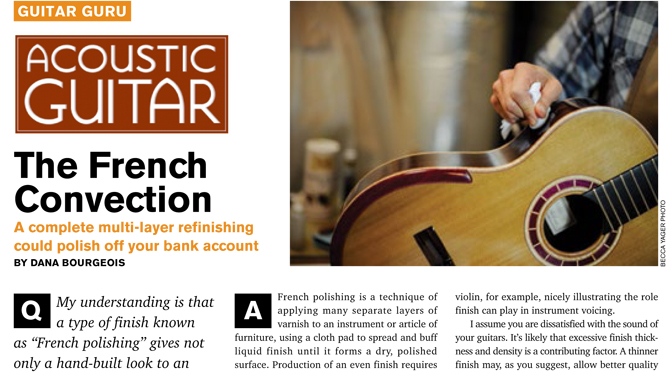Guitar Guru
Guitar Guru – French Polish
Dana Bourgeois contributes the monthly Guitar Guru column to Acoustic Guitar Magazine. If you a question you’d like Dana to address in an upcoming article, please submit it to [email protected].
Download a PDF of this article here
The French Convection -A complete multi-layer refinishing could polish off your bank account
Q: My understanding is that a type of finish known as “French polishing” gives not only a hand-built look to an instrument, but also a better quality of tone and a fuller sound. How does this process work, and is it worth having it done to my moderately priced Samick Greg Bennett Design D5? Ken Jarabek Victoria, B.C., Canada
A: French polishing is a technique of applying many separate layers of varnish to an instrument or article of furniture, using a cloth pad to spread and buff liquid finish until it forms a dry, polished surface. Production of an even finish requires considerable skill, elbow grease, and time. The finish material typically used in French polishing is either oil or spirit varnish.
The sonic benefit of varnish comes from the material itself rather than method of application. Most specifically, the sonic benefit of any finish depends on matching its properties of hardness and density with a specific instrument’s voicing requirements and on achieving appropriate finish thickness.
One advantage of French polishing is that the technique allows finish to be applied more thinly than can easily be achieved through other methods of application. And the thinner the finish, the less sonically important the finish material.
Think of finish as the final step in voicing. As with other elements of voicing, there is no right or wrong here, only what’s appropriate.
While a soft, relatively thick oil varnish will roll off high-end harshness in certain guitars, the same finish will cause high-end damping in others; some violin makers string and play a violin between finish coatings to determine optimum finish thickness for an individual violin, for example, nicely illustrating the role finish can play in instrument voicing.
I assume you are dissatisfied with the sound of your guitars. It’s likely that excessive finish thickness and density is a contributing factor. A thinner finish may, as you suggest, allow better quality tone and fuller sound. If, however, excessive finish density is a problem, French polishing over existing finish will not solve it.
Complete refinishing with a French polished varnish is an option that will likely improve the sound of your guitars and additionally give them a more handmade look. I’d be surprised, though, if a competently executed French polished refinish costs less than $1,500 to $2,000 per guitar. Neck and bridge must be disassembled, finish stripped, new finish painstakingly applied, then the guitar must be reassembled and set up. All steps must be expertly executed, otherwise the final product will look like a hack job. Refinishing just the top is an option, though still expensive.
If the cost of refinishing your guitars is not enough of a deterrent, consider that the original finishes may not be their only sonic liabilities. Instead of refinishing, I recommend investing in guitars that will make you smile without requiring modification.

